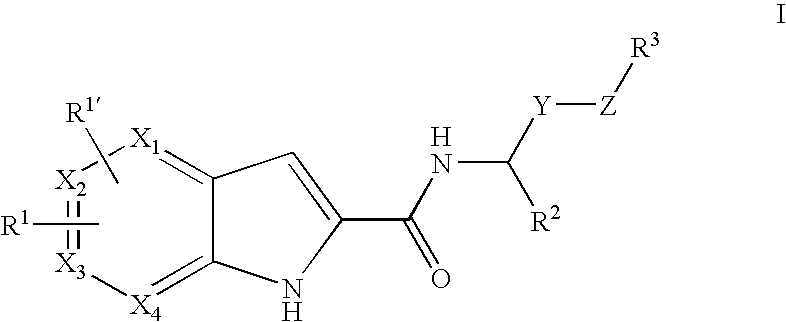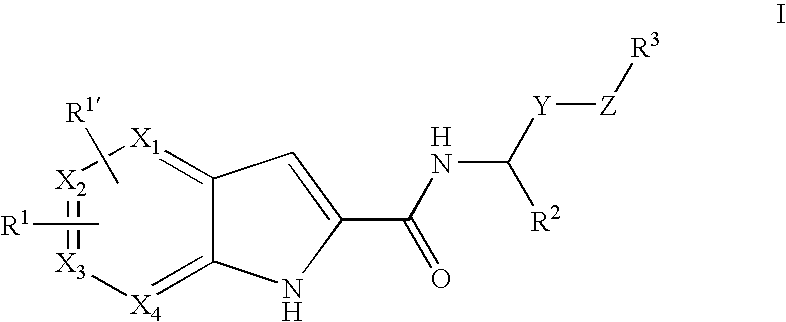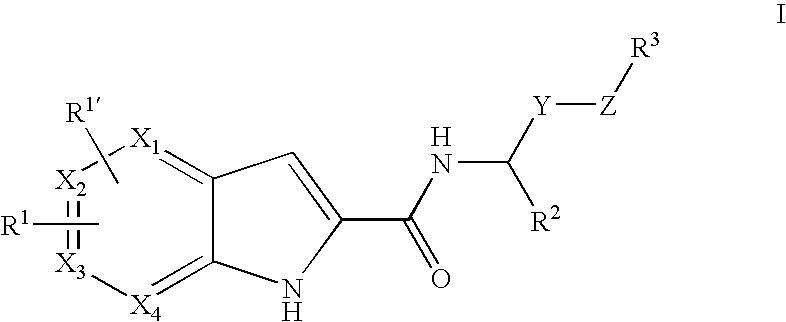Pyrrolopyridine-2-carboxylic acid amide inhibitors of glycogen phosphorylase
a glycogen phosphorylase and pyrrolopyridine technology, applied in the direction of biocide, drug composition, metabolic disorder, etc., can solve the problems of abnormal blood sugar levels, myocardial ischemia, and diabetes dependent type i and non-insulin dependent type ii diabetes continue to present treatment difficulties,
- Summary
- Abstract
- Description
- Claims
- Application Information
AI Technical Summary
Problems solved by technology
Method used
Image
Examples
example 1
5-Chloro-1H-pyrrolo[3,2-b]pyridine-2-carboxylic acid (1-dimethylcarbamoyl-2-(S)-phenylethyl)amide
[0294]
[0295] To a solution of 5-chloro-1H-pyrrolo[3,2-b]pyridine-2-carboxylic acid (Preparation 6, 36 mg, 0.18 mmol) in DMF (4 mL, anhydrous), was added 2-(S)-amino-N,N-dimethyl-3-phenylpropionamide hydrochloride (Preparation 8, 46 mg, 0.20 mmol), DIPEA (105 μL, 6.05 mmol) and HOBt (25 mg, 0.18 mmol) sequentially. The solution was stirred for 5 min prior to the addition of EDCI (42 mg, 0.22 mmol) in one portion. The resulting solution was stirred for 16 h at rt. The reaction mixture was partitioned between ethyl acetate (50 mL) and brine (20 mL). The layers were separated and the aqueous phase extracted with ethyl acetate (3×20 mL), then the combined organics were washed with water (3×10 mL) and brine (10 mL). The organic phase was dried (MgSO4), filtered and concentrated in vacuo. Purification via flash column chromatography eluting with methanol / dichloromethane (1:19) gave an orange o...
example 2
1H-pyrrolo [3,2-c]pyridine-2-carboxylic acid (1-dimethylcarbamoyl-2(S)-phenylethyl)amide
[0296]
[0297] To a solution of 1H-pyrrolo[3,2-c]pyridine-2-carboxylic acid (Preparation 12, 100 mg, 0.62 mmol) in DMF (15 mL) was added 2-(S)-amino-N,N-dimethyl-3-phenylpropionamide hydrochloride (Preparation 8, 141 mg, 0.62 mmol), HOBt (83 mg, 0.62 mmol) and DIPEA (0.21 mL, 1.23 mmol). After 30 min, EDCI (154 mg, 0.80 mmol) was added and the mixture was stirred at rt for 72 h. The solvent was removed in vacuo and the solid partitioned between water (50 mL) and ethyl acetate (3×50 mL). The combined organic layer was dried (MgSO4), concentrated in vacuo and purified by chromatography on silica gel using methanol / dichloromethane (6:94) as eluant to give the title compound as a beige solid. δH (CD3OD): 3.06-3.19 (2H, m), 4.83 (6H, s), 5.27 (1H, t), 7.20-7.32 (5H, m), 7.34 (1H, s), 7.45 (1H, d), 8.20 (1H, d), 8.87 (1H, s); m / z (ES+)=337 [M+H]+.
example 3
1H-Pyrrolo[2,3-c]pyridine-2-carboxylic acid (1-dimethylcarbamoyl-2(S)-phenylethyl)amide
[0298]
[0299] To a solution of 1H-pyrrolo[2,3-c]pyridine-2-carboxylic acid (Preparation 15, 100 mg, 0.62 mmol) in DMF (15 mL), was added 2-(S)-amino-N,N-dimethyl-3-phenylpropionamide hydrochloride (Preparation 8, 141 mg, 0.62 mmol), HOBt (83 mg, 0.62 mmol) and DIPEA (0.21 mL, 1.23 mmol). The reaction was stirred at rt for 0.5 h, followed by addition of EDCI (154 mg, 0.80 mmol). The mixture was stirred at rt for 72 h then partitioned between water (50 mL) and ethyl acetate (3×50 mL). The combined organic fractions were dried (MgSO4), concentrated in vacuo and chromatographed on silica gel eluting with methanol / dichloromethane (1:19) to give the title compound as a yellow solid. δH (CD3OD): 2.88 (6H, s), 3.07-3.20 (2H, m), 5.28 (1H, t), 7.20 (1H, s), 7.22-7.31 (5H, m), 7.65 (1H, d), 8.10 (1H, d), 8.76 (1H, s); m / z (ES+)=337 [M+H]+.
PUM
| Property | Measurement | Unit |
|---|---|---|
| body weight | aaaaa | aaaaa |
| temperature | aaaaa | aaaaa |
| temperature | aaaaa | aaaaa |
Abstract
Description
Claims
Application Information
 Login to View More
Login to View More - R&D
- Intellectual Property
- Life Sciences
- Materials
- Tech Scout
- Unparalleled Data Quality
- Higher Quality Content
- 60% Fewer Hallucinations
Browse by: Latest US Patents, China's latest patents, Technical Efficacy Thesaurus, Application Domain, Technology Topic, Popular Technical Reports.
© 2025 PatSnap. All rights reserved.Legal|Privacy policy|Modern Slavery Act Transparency Statement|Sitemap|About US| Contact US: help@patsnap.com



